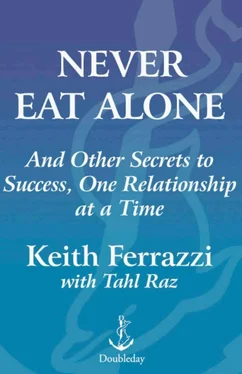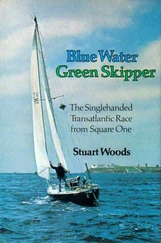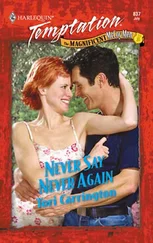Keith Ferrazzi - Never Eat Alone
Здесь есть возможность читать онлайн «Keith Ferrazzi - Never Eat Alone» весь текст электронной книги совершенно бесплатно (целиком полную версию без сокращений). В некоторых случаях можно слушать аудио, скачать через торрент в формате fb2 и присутствует краткое содержание. Год выпуска: 2005, ISBN: 2005, Издательство: C U R R E N C Y • D O U B L E D A Y, Жанр: marketing, на английском языке. Описание произведения, (предисловие) а так же отзывы посетителей доступны на портале библиотеки ЛибКат.
- Название:Never Eat Alone
- Автор:
- Издательство:C U R R E N C Y • D O U B L E D A Y
- Жанр:
- Год:2005
- ISBN:0-385-51529-4
- Рейтинг книги:4 / 5. Голосов: 1
-
Избранное:Добавить в избранное
- Отзывы:
-
Ваша оценка:
- 80
- 1
- 2
- 3
- 4
- 5
Never Eat Alone: краткое содержание, описание и аннотация
Предлагаем к чтению аннотацию, описание, краткое содержание или предисловие (зависит от того, что написал сам автор книги «Never Eat Alone»). Если вы не нашли необходимую информацию о книге — напишите в комментариях, мы постараемся отыскать её.
Never Eat Alone — читать онлайн бесплатно полную книгу (весь текст) целиком
Ниже представлен текст книги, разбитый по страницам. Система сохранения места последней прочитанной страницы, позволяет с удобством читать онлайн бесплатно книгу «Never Eat Alone», без необходимости каждый раз заново искать на чём Вы остановились. Поставьте закладку, и сможете в любой момент перейти на страницу, на которой закончили чтение.
Интервал:
Закладка:
The fact is that those people who are known beyond the walls of their own cubicle have a greater value. They find jobs more easily. They usually rise up the corporate ladder faster. Their networks begin to grow without much heavy lifting.
I can hear the groans of discomfort already stirring. You may be thinking, "I'm shy. I don't like to talk about myself. Isn't modesty a virtue?" Well, I can assure you that if you hide your accomplishments, they'll remain hidden. If you don't promote yourself, however graciously, no one else will.
Like it or not, your success is determined as much by how well others know your work as by the quality of your work. Luckily, there are hundreds of new channels and mediums for you to get the word out.
So how do you promote Brand You?
Every day, you read or hear about companies in newspapers, magazines, on television, and on the Web. Most of the time the article or story is about celebrity CEOs and big companies. It's not because they are more deserving of the press than you or me. It's the result of well-planned and strategic public relations. Big companies have PR machines working for them to shape and control their image (though not always successfully).
Smaller companies and individuals have to do it themselves. But by using some pluck and a strategy of your own, access to the media is not as difficult as you may think. Journalists do less sleuthing for their stories than you'd imagine. They get a majority of their stories from people that have sought them out, and not the other way around. And like everyone else in any profession, they tend to follow the herd. Which means once you get written about, other reporters will come calling. Assigned you as a subject, they'll do a quick Google search, and presto: They'll find you are an already cited source and will seek you out to cite you again.
One article creates visibility, which in turn will put you in front of other journalists, creating the possibility of more articles and visibility. A journalist's deadlines make magazine and newspaper work the art of the possible, not the perfect.
The key is to view the exposure of your brand as a PR campaign. How are you going to get your message out there? How are you going to make sure that the message gets out the way you want it to get out? Sure, your network is a good start. Everyone you meet and everyone you talk to should know what you do, why you're doing it, and how you can do it for him or her. But why not broadcast that same message to a thousand networks across the country?
Now we're talking.
As I mentioned before, when I became CEO of YaYa, it was a company with virtually no revenue, and clearly no recognized market. We had visionary founders, Jeremy Milken and Seth Gerson, but we needed a market.
There was, however, one company with a similar product. I'm going to call them Big Boy Software. They had created a software tool that facilitated the actual creation of high-end games. They too were trying to find their business model and generate revenue. Both of us were in a race to become the established brand in the new market we were creating.
Soon after we defined the advergaming space, Big Boy saw how YaYa was picking up steam (and generating operating revenue) selling games to big brands. They followed suit, positioning themselves as competitors to YaYa. The main difference between them and us was that they had way, way more money. They had raised a huge amount of capital that put our resources to shame. There is no need to go into the comparative details of who was a better company (I'm a little biased, of course). But the fact remains, they had tons of resources and we did not—at all.
So how did YaYa become the market leader?
The answer is, we created buzz: that powerful, widespread phenomenon that can determine the future of individuals, companies, and movies alike. Buzz is the riddle every enterprising person is trying to solve. It's a grassroots, word-of-mouth force that can turn a low-budget flick about a witch into a multimillion-dollar blockbuster. (Ever hear of The Blair Witch Project?) You feel its energy in Internet chat rooms, at the gym, on the street, and all of it is stoked by a media hungry for the inside scoop. Buzz is marketing on steroids.
Here's an example of how well it works: Remember Napster? One day it was a clever software idea hatched in some kid's dorm room allowing users online to link up and share MP3 music files. Six months later, it was a Silicon Valley start-up, the source of a major lawsuit, playing bandwidth havoc with servers around the country. Even when it was shut down, the name had enough buzz to be bought for something like $50 million.
Advertising or a life-empowering endorsement by Oprah had nothing to do with it. Napster was, well, cool. And as a result of buzz, it was very famous.
As a marketer, over the years, I have developed an idea of how buzz is created. One way is to generate what I call "catalytic moments." When you watch a big football game, have you noticed how the tide of a game will suddently turn in favor of one team or the other? It starts with a huge play, and in many cases is followed by more key plays. Buzz is like that. It needs a situation, a pivotal moment, an inside scoop, a crazy giveaway—something that will get the crowd whispering. Unfortunately, YaYa was too young and poor for such a strategy.
Another way is to report compelling news by leveraging the power of the media to get your brand sizzling. The Jesse Ventura for Governor of Minnesota campaign is a perfect example. Significantly outspent by two major competitors, Ventura gained valuable media exposure by persuading the media to report on things like his creative use of advertising and a G.I. Joe-like action figure. Similarly, I look for compelling stories that create buzz within the news media.
That's where feeding the "infiuentials" comes into play. Infiuentials are what marketing wonks call those people who can ignite brand buzz. They are the small segment of the population that will adopt a cool product early on and infect everyone else with the bug. They are also the celebrities and experts whose word is gospel. It's imperative that you identify those people and get your brand in front of them.
I mentioned the KPE agency before. They were just what I was looking for. An interactive marketing and technology consultancy on the cutting edge, KPE had taken an early interest in the new space we were creating. They were a recognized name among Fortune 1000 companies known for spotting the newest trends. Happily, their head of strategy was Matt Ringel, whom I had gotten to know from our mutual interest in the nonprofit devoted to preserving objects and places of historical significance, called "Save American Treasures."
I reached out to Matt and proposed that he lead an effort to write an article introducing this space to the market. I knew that a white paper (research documents that consulting companies put out on hot topics of the day) introducing us and the technology from an unbiased perspective would be far more effective and lead to more credibility than anything we could do ourselves. I worked with Matt and his right hand, Jane Chen, for weeks on the paper, giving them examples from YaYa, getting clients to speak with them, introducing methodologies and insights that we had gained through our experience. I had gone to analysts before this who were interested in the space and were now willing to speak to Matt about what we were doing as well.
I was giving KPE another opportunity to look cutting edge and take a leadership position in the space, while in return, just by dint of the access I was giving KPE, I bet that YaYa would be the primary example in the case study. Great things came from the article, including the new name for the space, which we called (thanks to the creativity of Jane Chen) "Advergaming." The name alone had buzz.
Читать дальшеИнтервал:
Закладка:
Похожие книги на «Never Eat Alone»
Представляем Вашему вниманию похожие книги на «Never Eat Alone» списком для выбора. Мы отобрали схожую по названию и смыслу литературу в надежде предоставить читателям больше вариантов отыскать новые, интересные, ещё непрочитанные произведения.
Обсуждение, отзывы о книге «Never Eat Alone» и просто собственные мнения читателей. Оставьте ваши комментарии, напишите, что Вы думаете о произведении, его смысле или главных героях. Укажите что конкретно понравилось, а что нет, и почему Вы так считаете.












